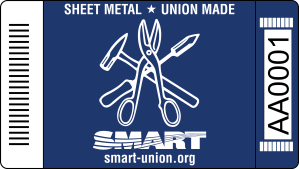


What is the union label?
The label is a tool for protecting union jobs, wages, and benefits. And it’s an essential tool for enforcing contracts. The labels encourage employers to use union-made products. Labels protect wages in two ways: first, by ensuring building trades fabricated materials are constructed per the area standard wage (average crew cost) under the contract for the jurisdiction where the jobsite is located, which is required by the subcontracting restrictions in the union contract; and, second, by identifying which SMART bargaining area fabricated the union products to ensure that, through wage equalization, the lower-paid workers in the fabrication shop receive the same average crew cost as the higher-paid workers at the jobsite (when applicable). They’re also a sign of quality craftsmanship done by skilled union workers.
How does the label system work?
SMART members working in fabrication shops put labels on union-made products. SMART members who are installers check for the label on products arriving on construction sites. If there is no label on a yellow-label product, installers should contact their business rep. so he can enforce the contract that requires contractors to prove that they are at least paying the same wage rates for products installed (even if they’re not union made).
On products with labels, installers check to see which SMART contract area produced it by scanning the bar codes or reading the numbers on the labels. The bar codes and numbers are linked to information about which union shop produced it and the shop’s wage rate (average crew cost, including benefit costs). Only then can wage equalization take place. The system relies on the vigilance and commitment of SMART union sheet metal workers throughout the process.
What’s the difference between the yellow and blue labels?
The blue label is used on production products. The yellow label represents building trades products. Yellow labels are used to enforce subcontracting standards and for wage equalization.
How do the labels help enforce contracts?
All SMART union building trades contracts require that contractors either use yellow-labeled products or prove that the non-union workers who made non-labeled products were paid the same rate as the local union workers earn. As you can imagine, proving that can be tough. What did a worker in China earn? How much did the fabricator of a product bought in a store make? The installing contractor is required to prove they earned the same. The label is the simple way to prove it.
Who is responsible for making the label system work?
All SMART union sheet metal workers have a role to play in making the label system work. The labels must be put on in the first place. Installers must check to see if products are labeled, reporting when they’re not, and scan in the information about which SMART contract area produced it. Local union leaders must support installers who report non-labeled products and enforce contracts, promote the use of the labels (with contractors and SMART union members), and ensure maintenance of subcontracting standards and wage equalization takes place.
How does wage equalization work?
Wage equalization removes the incentive for employers to use yellow-label products fabricated by union workers getting lower wage rates. By scanning the labels to report which shop produced a product, everyone in the process from fabricators to installers gets the highest average crew cost rate.
In other words, if a contractor ships in product from a lower-rate local for a higher-rate local to install, the contractor will have to pay the higher average crew cost rate.
Who benefits from wage equalization?
Everyone benefits from wage equalization. First, a fabricator in a lower-rate local who gets a boost in pay from wage equalization benefits most directly. His pay goes up. But wage equalization helps higher-rate sheet metal workers too by removing the incentive contractors have to look for fabricated products from areas with a lower average crew cost. Otherwise, contractors could pursue a race to the bottom that puts pressure on all locals to accept lower wages.
What is the difference between the roles played by rank-and-file members and union leaders in making the label system work?
The system only works if both local leaders and rank-and-file sheet metal workers do their part. The rank-and-file are the hands, eyes, and voices that apply the labels, see if they’re on products arriving on job sites, raise their voices to report when labels aren’t there, and scan them when they are. Local union leaders must back up workers in fabrication shops and on construction sites, making sure labels are available in fabrication shops, taking action when installers report non-labeled products, and ensuring that everyone in the local knows how the system works. And the International must ensure that the entire system functions and supply the data that facilitates wage equalization.
Union members can ask their employer to only use labeled materials. Local union officials have a duty to enforce contracts. They can also encourage contractors to only use products with the union label and provide lists of manufacturers who produce labeled union products.